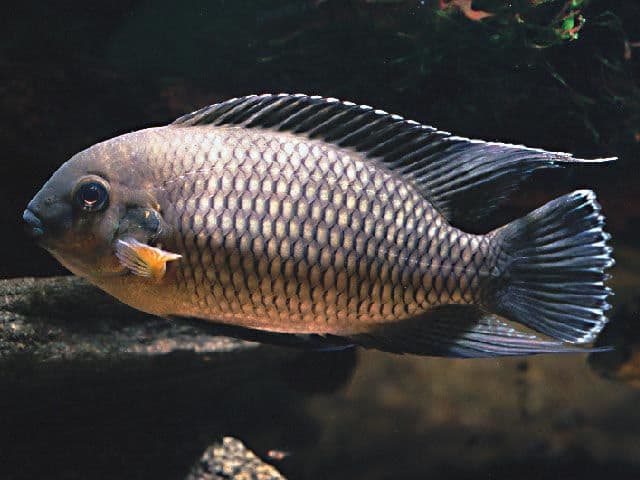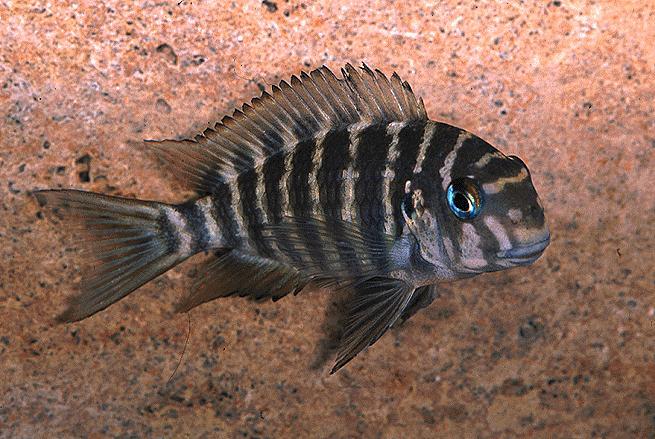Lets start with the “no”
which began about three years ago. Although Im not a fan of African cichlids, I am a fan of West African cichlids, and one of the few source books on this group is “Cichlids from West Africa”, by Linke and Staeck. This book created a desire for many fish rarely seen in the hobby and started my West African wish list. The last fish on my list was “The Poor Mans Tropheus” as some authors refer to it, Tilapia joka. It wasnt last for lack of want but last because it was on the last page of this book.

Joka piqued my interest because of their relatively small size, reaching only four inches and their pleasing color pattern reminding me of the pattern of many juvenile Tropheus varieties. They have the oval blunt shape of a Tropheus but none of their attitude. They have a simple pattern of creamy vertical stripes on a basic black fish. The first ones I saw were at Hoffers Tropic Life and I couldnt pass them up taking six home with me. I kept these for a year watching them grow to full size without ever giving me any indication they would spawn. As they reached four inches they did lose the stripes except when stressed and turned into a brown fish with golden spangles highlighting the entire body. Boredom set in and I gave them away.
The next encounter with Tilapia joka was at the 2001 GCCA Classic. Waterlife Imports had a tank full of one-inch youngsters. I couldnt think why I gave them away, they were so cute, and took home eight this time. Soon, I noticed a difference from my original group. They had the same basic black and white pattern but all showed a colored edge on their otherwise clear tails. This edge of color was either showing a blue tint or a pinkish tint. I figured these must have come from a different location than my first group. In a few weeks time, they grew to nearly three inches. At this point the larger ones had pointed dorsal fins and blue-white tail edges and the smaller ones had reddish tail edges. Could they be males vs females?
This was shortly answered. Yes, the red edges were female which they proved by spawning. I had them in a 55 gal. in tap water and they were doing fine, so I left them alone. They ate the first spawn, which was on a small piece of slate. Another pair formed and spawned a couple weeks later vigorously defending their PVC elbow from the pair with the slate. They also ate their spawn. This repeated a few times for each pair until they settled down. They both stopped eating their eggs, but now they wouldnt hatch.
I did pull a spawn from each pair but to no avail; they fungussed and failed to hatch. They had done so well in tap water I didnt think they needed soft conditions but it was time to try a change. I started to replace their water with 80% RO water and waited. They continued to spawn; the eggs failed to hatch. Still no luck. They were not supposed to be that difficult. Maybe they were late bloomers and needed more time?
After many spawns, I decided to increase the frequency of their water changes and also try to give them straight RO water. This worked, sort of. I got two eggs to hatch. I persisted and the next spawn looked to have 50-60 eggs that were good. I pulled the spawn after two days and expected a hatch the next day. Half the good eggs fungussed but I did have about 30 fry. I was pleased. The fry were able to eat baby brine shrimp from the start and grew steadily. The adults did like their greens too, so I added green flake, Wardleys of course, as soon as they could take it.
The other pair in the meantime spawned. I left them to the parents’ care. They proved to be excellent parents and had about 100 babies they paraded around the tank. I didnt need more fry so I left them alone figuring the other fish would eat them as they grew. I still have 20 babies from that spawn.
On to the Yes.
Although I hate to admit it and try to hide it when it happens, sometimes I do buy East Africans in spite of their bright colors. At the same time I had another 55 gal. with 8 young near adult Tropheus annectens. I was doing my occasional rounds of the shops and came across a tank of 2.5 inch Tropheus sp. Red at Aqua Exhibits. They were in excellent shape and going through pre-spawning displays. They were jet black with brilliant red dorsal fins and when really excited the red flushed through much of their bodies. They were gorgeous. I wanted them. They were smaller than my annectens but I thought they might be a good companion fish for them. The only problem was I had been very lax in my water changes and the 55 was filthy. I told myself to wait until I cleaned up the tank and moved out a couple other fish and if the Reds were still there, Id buy them.

I did my cleaning and transfers and rushed back to Aqua Exhibits the next day. All the Reds were still there. The price was very reasonable for any Tropheus (I had also bought the annectens there) but how many did I need? Was four enough? Was six too many? Could I sex them? The longer I watched them, the more I wanted. I settled for eight. They were carefully dumped into the 55 after I moved a couple rocks and spooked the annectens trying to break up any territories. Later that evening, at feeding time the Reds had settled in. Even though the annectens were nearly an inch larger, the Reds were holding their own. The largest male annectens had commandeered the clay saucer as his own but the Reds challenged him every chance they had.
I thought the Reds were about 3 or 4 months from being adult and wouldnt have too much trouble until then. Two weeks later, I noticed one of the females looked like she had a mouthful of eggs. I watched her at feeding time and she ate, but she didnt attack the food like the others. Theyre too young I thought. After two more weeks I convinced myself she might have spawned. As much as I hate catching fish, I decided to try and catch her and make sure she had fry by stripping her. I didnt want to go nuts chasing, so I gave myself one chance to catch her.
I got out the 10 inch net and waited for her to retreat to the floating plastic plant she usually hid out in. Swoop, first try and she was in the net. I stripped her and got 6 babies with a small yolk sac attached. I was pleased. A couple days later, I actually witnessed another female spawning. It was a real comedy of errors.
The male Red really wanted the clay saucer but every time he approached it, the larger male annectens would chase him off. The Red was vigorously courting the female, shaking and bending and diving towards the rocks above the saucer. This displeased the annectens also. He would blast through their courtship display and send them running. The male red finally would shoot the female a quickie, just below the top of the rock pile; she’d squirt out an egg and in a flash spin around and catch it before it even hit the rocks. The male annectens would spot the disturbance and blast through their tryst. At least I know it wasnt just a fluke and the Reds were old enough to spawn.
The babies have been fairly easy to raise on Wardleys Spirulina Flakes and a little baby brine. They are a little over an inch at 4 months old and starting to show adult colors. These are the most brilliant Tropheus and so colorful, I let the algae grow on the glass so you cant see them. I dont want to upset my “Brown” reputation.
Leave a Reply